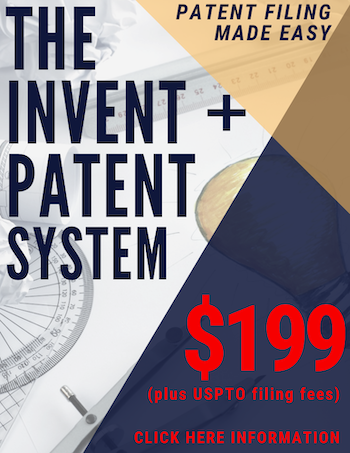“Unfortunately, while describing use and functionality of an invention is necessary, no amount of description of use and/or function will make up for an insufficient description of the technology from a structural and mechanical perspective.”
 The patent process actually starts well before you file a patent application or seek assistance from a patent attorney. Every patent application starts with an invention, and every invention starts with an idea. While ideas are not patentable, there will be a point in time when the idea you are working on comes so into focus with enough detail that it will cross the idea / invention boundary. It is when an idea matures to the point of being concrete and tangible enough to be described to another that the idea has become an invention, at least in general terms.
The patent process actually starts well before you file a patent application or seek assistance from a patent attorney. Every patent application starts with an invention, and every invention starts with an idea. While ideas are not patentable, there will be a point in time when the idea you are working on comes so into focus with enough detail that it will cross the idea / invention boundary. It is when an idea matures to the point of being concrete and tangible enough to be described to another that the idea has become an invention, at least in general terms.
Legally speaking, in order to have a protectable invention you have to be able to describe your invention with enough detail so that someone of skill in the relevant technical field or scientific area can understand how to both make and use the invention having only read your description of the invention, which can and absolutely should be supplemented with as many high quality patent drawings as possible. The goal is to take your idea and transform it into something akin to an instruction manual both on use and mechanics. Those new to the patent space tend to be very good at describing the use and less good at describing the mechanics of the invention. Unfortunately, while describing use and functionality of an invention is necessary, no amount of description of use and/or function will make up for an insufficient description of the technology from a structural and mechanical perspective.
“It slices! It dices!” Great, but what is “it” and how exactly does it slice and dice?
Explain “How”, Not “What” of the Invention
Focusing on use and functionality is one of the biggest mistakes inventors and new patent practitioners make. They spend too much time talking about what the invention does and very little time explaining what the invention is and how it operates on a mechanical, structural and electrical level to deliver the functionality being described. In other words, the copy is written as if it is for an infomercial, or perhaps for a business plan. Neither infomercial nor business plan writing is appropriate in a patent application. What you need is technical writing, which is why patent drawings are so helpful. Those drawings provide disclosure in and of themselves, and if you are doing what you are supposed to do then you will be describing what each drawing specifically shows and how the pieces and parts are connected and relate on a structural level. See Working with Patent Illustrations.
If you find yourself struggling at the idea phase and are unable to break through please see Moving from Idea to Patent. When you are attempting to move from idea to invention, regardless of how or why you find yourself stuck in the idea phase, the first order of business is to get the ball rolling. You need momentum. It’s like that song: put one foot in front of the other and soon you will be walking across the floor. Specifically identify the problem you want to solve and keep adding ideas and thoughts layer by layer. Keep copious notes because some things that seem like good ideas will eventually become bad, and things that were initially viewed as bad ideas will eventually become good. The more thoughts and ideas you layer onto your solution, the more details you add, at some point you will cross that idea / invention boundary and be squarely on the invention side of the line.
Get Your Provisional
 Once you do cross the idea / invention boundary and you are ready to file a patent application the prevailing advice for many years was to first conduct a patent search. This was because doing a patent search is the only way to get a realistic idea about whether the invention is likely able to be protected. While inventors really do need to do some searching on their own to ensure they are not pursing a dead-end path (see Patent Searching 101: A Patent Search Tutorial), since 2013 U.S. patent laws have become first inventor to file, which really must be interpreted as requiring inventors to file first, period. Therefore, current best practice is to file the most comprehensive provisional patent application possible. Obviously, describing the invention completely, both in general terms and specific terms, is necessary in order to create a meaningful priority filing that can be relied upon later. Then, after a priority filing date has been obtained, having a professional patent search done and obtaining an opinion from a patent practitioner prior to filing a nonprovisional patent application is the appropriate course of action.
Once you do cross the idea / invention boundary and you are ready to file a patent application the prevailing advice for many years was to first conduct a patent search. This was because doing a patent search is the only way to get a realistic idea about whether the invention is likely able to be protected. While inventors really do need to do some searching on their own to ensure they are not pursing a dead-end path (see Patent Searching 101: A Patent Search Tutorial), since 2013 U.S. patent laws have become first inventor to file, which really must be interpreted as requiring inventors to file first, period. Therefore, current best practice is to file the most comprehensive provisional patent application possible. Obviously, describing the invention completely, both in general terms and specific terms, is necessary in order to create a meaningful priority filing that can be relied upon later. Then, after a priority filing date has been obtained, having a professional patent search done and obtaining an opinion from a patent practitioner prior to filing a nonprovisional patent application is the appropriate course of action.
For more information and tutorials please see Invention to Patent 101, which includes dozens of articles on IPWatchdog.com arranged as “reading assignments”.
Happy inventing!

![[IPWatchdog Logo]](https://ipwatchdog.com/wp-content/themes/IPWatchdog%20-%202023/assets/images/temp/logo-small@2x.png)

![[[Advertisement]]](https://ipwatchdog.com/wp-content/uploads/2018/10/Enhance-1-IPWatchdog-Ad-2499x833-1.png)
![[Advertisement]](https://ipwatchdog.com/wp-content/uploads/2024/04/UnitedLex-May-2-2024-sidebar-700x500-1.jpg)
![[Advertisement]](https://ipwatchdog.com/wp-content/uploads/2024/04/Artificial-Intelligence-2024-REPLAY-sidebar-700x500-corrected.jpg)
![[Advertisement]](https://ipwatchdog.com/wp-content/uploads/2024/04/Patent-Litigation-Masters-2024-sidebar-700x500-1.jpg)

![[Advertisement]](https://ipwatchdog.com/wp-content/uploads/2021/12/WEBINAR-336-x-280-px.png)
![[Advertisement]](https://ipwatchdog.com/wp-content/uploads/2021/12/2021-Patent-Practice-on-Demand-recorded-Feb-2021-336-x-280.jpg)
![[Advertisement]](https://ipwatchdog.com/wp-content/uploads/2021/12/Ad-4-The-Invent-Patent-System™.png)






Join the Discussion
3 comments so far.
angry dude
September 22, 2019 06:47 pmTernary @2
You have to make a distinction between two classes of patentable inventions (it is artificial classification of course because in reality there is no sharp boundary between the two):
1) Invention can be hidden behind trade secrets for some period of time (e.g. few months or few years) after it’s released to a general public (e.g. goes on sale at Walmart)
2) Invention can’t be a trade secret because reverse engineering is too easy so once it out there everybody can start making and selling exact same thing in a matter of weeks or even hours (using modern 3d scanners and 3d printers)
Example of 1) is some novel functionality enabled by embedded software algorithms (e.g. self-balancing board patent co-owned by Mark Cuban and discussed here a while ago) which can be difficult and costly to completely reverse-engineer beyond basic mechanical and electrical parts
Example of 2) – “Bunch-of-balloons” sold at Walmart
If you are in category 2) then you’d better have at least provisional before it goes on sale – even as a lottery ticket for future drawings
Otherwise you have nothing, absolutely NOTHING to show
Or just keep it in your head until things improve
Might as well go fishing
But if you are in category 1) then, as things stand right now, you gotta be a complete self-destructing idiot to publicly disclose all of the details in your patent application for the entire world to see…
Might go fishing as well
Sad…
Ternary
September 22, 2019 12:26 pm“The goal is to take your idea and transform it into something akin to an instruction manual both on use and mechanics.” Not to discourage novice applicants, but you basically hand over your invention to the public domain, unless you mark the box in the ADS that prevents publication of the application. Even when a patent is issued, there is limited chance to get any remuneration or acknowledgement for the invention, unless the applicant is going to build a product or service. And even then.
My advice is to file a provisional patent application. (filing cost is $70 for a micro entity and it is not published.) If you plan to license your (eventual) patent, make a list of companies that could be interested in your invention. Contact these companies after filing the provisional to find out if they are interested. (beware that prematurely offering for sale of your patented invention may create potential problems in the future). You have about 10 months to find out if you want to file a non-provisional (assuming you need some time to draft a non-provisional). As many of us, you may find out that there is no or very limited response. You have to draw your own conclusions on a lack of response. However, it is a good indicator of the problems you may face to try monetizing your patent.
In hindsight, no matter how brilliant your invention, you may feel naive or taken advantage of, by publishing in detail how to make and use your invention and getting nothing, not even the slightest form of recognition or appreciation, in return. In effect, many people will find you to be a profiteer (and will say so,) by obtaining a patent for an invention that, when patented and asserted, will be accused of being stupid, well-known, conventional, obvious, abstract or just plainly being a bad invention. When asserted, opponents will have no shame or qualms to accuse your invention/patent to be of bad quality.
It is great fun and very satisfying to do an invention. That is, to take an idea to a patentable device or method. You may have that feeling of elation right now. And rightfully so. As an independent inventor you are part of an American elite, a group of independent thinkers who advanced technology and the economy of a backward agricultural society to the most powerful nation. However, it is of questionable wisdom or perhaps even a bad idea for an independent inventor to pursue a patent in the current condition of our patent system. If you don’t believe it, read the posts at IPWatchdog. At least, do some research on the value of patents, before you start this journey.
Autrige Dennis
September 21, 2019 01:41 pmGreat article. It will help me a lot when suggesting drawings for my client’s invention. We usually suggest drawings in written form to inventors who don’t know what drawings to send. The article will help them see what’s important in their invention description. The article is written in a way even an inventor can understand. I’ll send all inventors here. Thank you IPWatchdog.